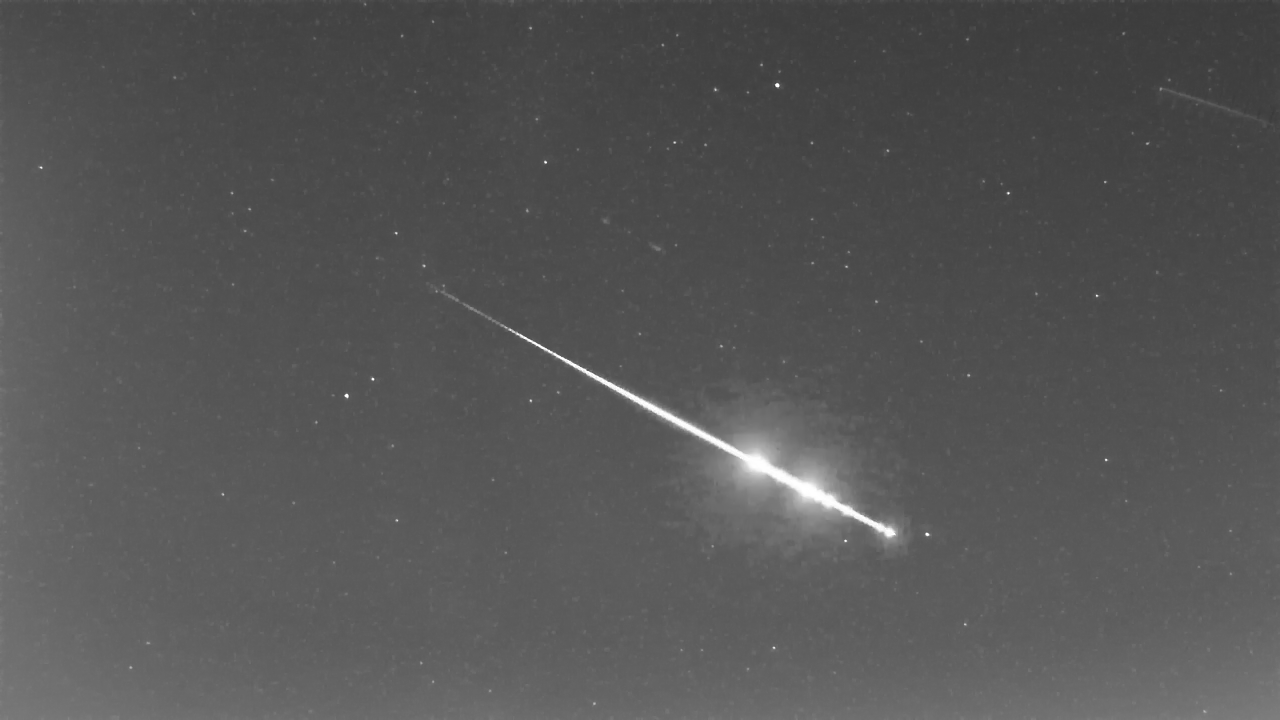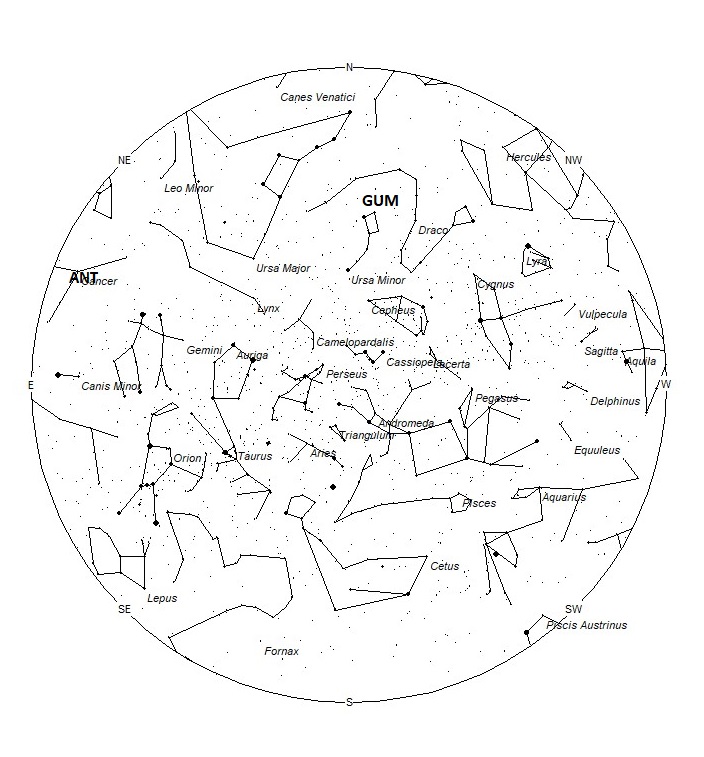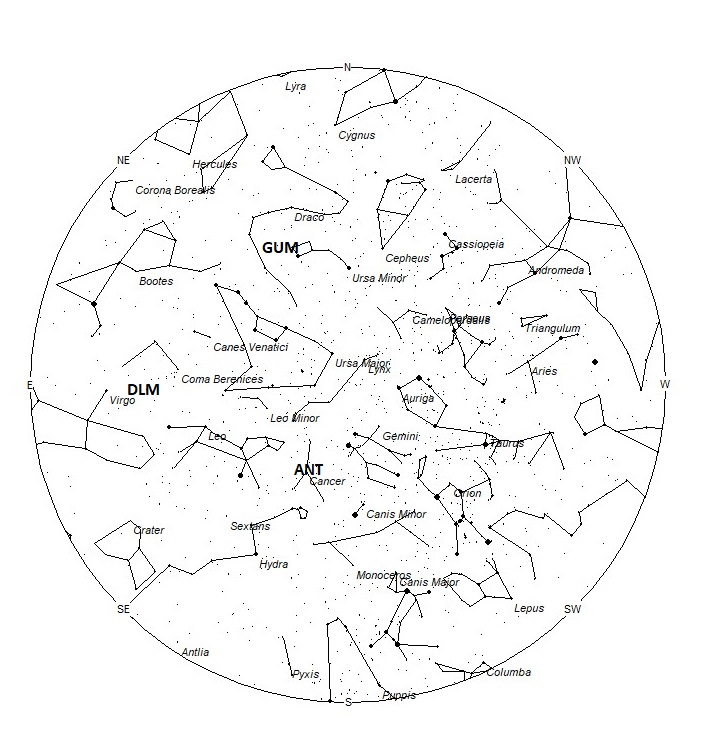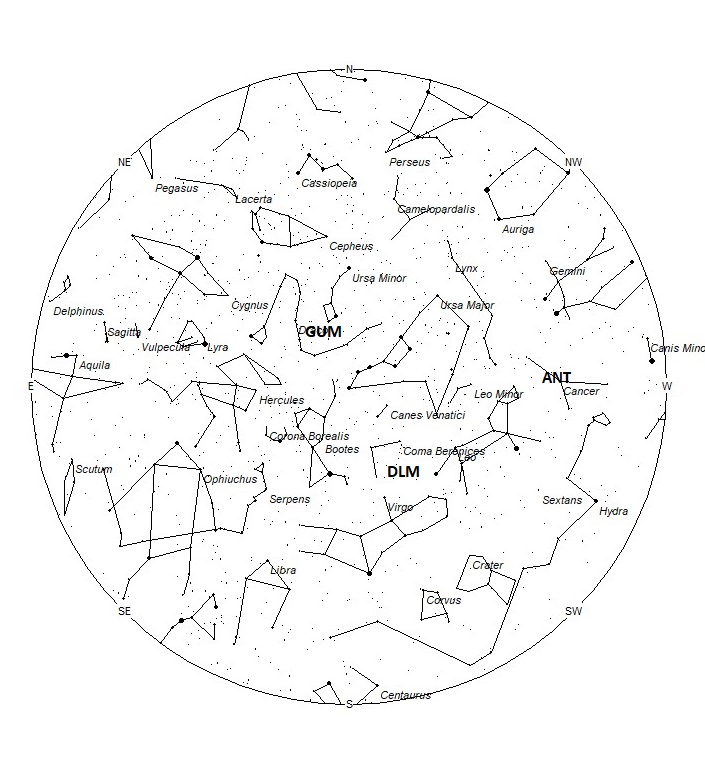 Richard Bassom captured this impressive fireball at 08:48 UT on 26 October 2020, from Ringwood, England. Notice the multiple bursts along the trail and at the end. Credit Richard Bassom
Richard Bassom captured this impressive fireball at 08:48 UT on 26 October 2020, from Ringwood, England. Notice the multiple bursts along the trail and at the end. Credit Richard BassomDuring this period, the moon reaches its first quarter phase on Thursday January 21st. At this time, the moon is located 90 degrees east of the sun in the sky and sets near 0100 local standard time. This weekend the waxing crescent moon will be present in the western sky after dusk but will soon set, leaving the remainder of the night free from interfering moonlight. The estimated total hourly meteor rates for evening observers this week is near 3 as seen from mid-northern latitudes and 3 as seen from tropical southern locations (25S). For morning observers, the estimated total hourly rates should be near 14 as seen from mid-northern latitudes (45N) and 11 as seen from tropical southern locations (25S). The actual rates will also depend on factors such as personal light and motion perception, local weather conditions, alertness, and experience in watching meteor activity. Note that the hourly rates listed below are estimates as viewed from dark sky sites away from urban light sources. Observers viewing from urban areas will see less activity as only the brighter meteors will be visible from such locations.
The radiant (the area of the sky where meteors appear to shoot from) positions and rates listed below are exact for Saturday night/Sunday morning January 16/17. These positions do not change greatly day to day so the listed coordinates may be used during this entire period. Most star atlases (available at science stores and planetariums) will provide maps with grid lines of the celestial coordinates so that you may find out exactly where these positions are located in the sky. A planisphere or computer planetarium program is also useful in showing the sky at any time of night on any date of the year. Activity from each radiant is best seen when it is positioned highest in the sky, either due north or south along the meridian, depending on your latitude. It must be remembered that meteor activity is rarely seen at the radiant position. Rather they shoot outwards from the radiant, so it is best to center your field of view so that the radiant lies at the edge and not the center. Viewing there will allow you to easily trace the path of each meteor back to the radiant (if it is a shower member) or in another direction if it is sporadic. Meteor activity is not seen from radiants that are located far below the horizon. The positions below are listed in a west to east manner in order of right ascension (celestial longitude). The positions listed first are located further west therefore are accessible earlier in the night while those listed further down the list rise later in the night.
These sources of meteoric activity are expected to be active this week.
.
The Anthelion (ANT) radiant is active from a position located at 08:36 (129) +19. This position lies in central Cancer, 2 degrees northwest of the 4th magnitude star known as Asellus Australis (delta Cancri). This radiant is a very large oval some thirty degrees wide by fifteen degrees high. Activity from this radiant can appear from more than one constellation., This week though, the Anthelion activity is limited to the constellation of Cancer. There are several lists that have the delta Cancrids currently active, but we include them with the Anthelions as the celestial positions overlap. The position listed here is for the center of the radiant. This radiant is best placed near 01:00 Local Standard Time (LST) when it lies on the meridian and is highest in the sky. Rates at this time should be near 3 per hour as seen from the northern hemisphere and 2 per hour as seen from south of the equator. With an entry velocity of 30 km/sec., the average Anthelion meteor would be of slow velocity.
The December Leonis Minorids (DLM) are a shower of long duration active from November 22 through February 10th. Maximum occurred near December 20th. The radiant is currently located at 12:25 (186) +18. This position lies in western Coma Berenices, 2 degrees west of the faint star known as 24 Comae Berenices. These meteors are best seen near 0500 LST when the radiant lies highest above the horizon. Current hourly rates are expected to be near 1 as seen from the northern hemisphere and less than 1 as seen from south of the equator. At 63 km/sec. the December Leonis Minorids produce mostly swift meteors.
The gamma Ursae Minorids (GUM) are another source discovered by Dr. Peter Brown and associates. These meteors are active from January 9-20, with maximum activity occurring near January 18. The radiant is currently located at 15:13 (228) +70 which places it southern Ursa Minor, 2 degrees south of the 3rd magnitude star known as Pherkad (gamma Ursae Minoris). These meteors are best seen during the last few hours before dawn, when the radiant lies highest in a dark sky. Current rates should be near 1 per hour as seen from the northern hemisphere and less than 1 as seen from south of the equator. These meteors encounter the atmosphere at 30 km/sec., which would produce meteors of medium-slow velocity.
No matter your location, sporadic rates should be near 9 meteors per hour during the last hour before dawn as seen from rural observing sites. Evening rates would be near 3 per hour. Locations between these two extremes would see activity between the listed figures.
The list below offers the information from above in tabular form. Rates and positions are exact for Saturday night/Sunday morning except where noted in the shower descriptions.
| SHOWER | DATE OF MAXIMUM ACTIVITY | CELESTIAL POSITION | ENTRY VELOCITY | CULMINATION | HOURLY RATE | CLASS |
| RA (RA in Deg.) DEC | Km/Sec | Local Standard Time | North-South | |||
| Anthelion (ANT) | – | 08:36 (129) +19 | 30 | 01:00 | 3 – 2 | II |
| December Leonis Minorids (DLM) | Dec 20 | 12:25 (186) +18 | 63 | 05:00 | 1 – <1 | II |
| gamma Ursae Minorids (GUM) | Jan 18 | 15:13 (228) +70 | 30 | 08:00 | 1 – <1 | IV |







 You saw something bright and fast? Like a huge shooting star? Report it: it may be a fireball.
You saw something bright and fast? Like a huge shooting star? Report it: it may be a fireball.  You counted meteors last night? Share your results with us!
You counted meteors last night? Share your results with us!  You took a photo of a meteor or fireball? You have a screenshot of your cam? Share it with us!
You took a photo of a meteor or fireball? You have a screenshot of your cam? Share it with us!  You caught a meteor or fireball on video? Share your video with us!
You caught a meteor or fireball on video? Share your video with us!